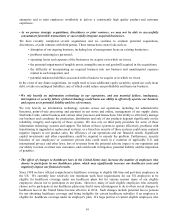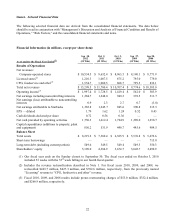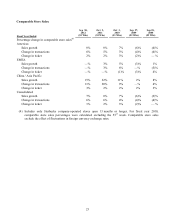Starbucks 2012 Annual Report Download - page 22
Download and view the complete annual report
Please find page 22 of the 2012 Starbucks annual report below. You can navigate through the pages in the report by either clicking on the pages listed below, or by using the keyword search tool below to find specific information within the annual report.16
enterprise and to train employees worldwide to deliver a consistently high quality product and customer
experience.
•As we pursue strategic acquisitions, divestitures or joint ventures, we may not be able to successfully
consummate favorable transactions or successfully integrate acquired businesses.
We have recently completed several acquisitions and we continue to evaluate potential acquisitions,
divestitures, or joint ventures with third parties. These transactions create risks such as:
• disruption of our ongoing business, including loss of management focus on existing businesses;
• problems retaining key personnel;
• operating losses and expenses of the businesses we acquire or in which we invest;
• the potential impairment of tangible assets, intangible assets and goodwill acquired in the acquisitions;
• the difficulty of incorporating an acquired business into our business and unanticipated expenses
related to such integration; and
• potential unknown liabilities associated with a business we acquire or in which we invest
In the event of any future acquisitions, we might need to issue additional equity securities, spend our cash, incur
debt, or take on contingent liabilities, any of which could reduce our profitability and harm our business.
•We rely heavily on information technology in our operations, and any material failure, inadequacy,
interruption or security failure of that technology could harm our ability to effectively operate our business
and expose us to potential liability and loss of revenues.
We rely heavily on information technology systems across our operations, including for administrative
functions, point-of-sale processing and payment in our stores and online, management of our supply chain,
Starbucks Cards, online business and various other processes and transactions. Our ability to effectively manage
our business and coordinate the production, distribution and sale of our products depends significantly on the
reliability, integrity and capacity of these systems. We also rely on third party providers for some of these
information technology systems and support. The failure of these systems to operate effectively, problems with
transitioning to upgraded or replacement systems, or a breach in security of these systems could cause material
negative impacts to our product sales, the efficiency of our operations and our financial results. Significant
capital investments and other expenditures could be required to remedy the problem. Furthermore, security
breaches of our employees' or customers' private data could result in a violation of applicable U.S. and
international privacy and other laws, loss of revenues from the potential adverse impact to our reputation and
our ability to retain or attract new customers, and could result in litigation, potential liability and the imposition
of penalties.
•The effect of changes to healthcare laws in the United States may increase the number of employees who
choose to participate in our healthcare plans, which may significantly increase our healthcare costs and
negatively impact our financial results.
Since 1988 we have offered comprehensive healthcare coverage to eligible full-time and part-time employees in
the US. We currently have relatively low minimum work hour requirements for our US employees to be
eligible for healthcare coverage under our healthcare plans but for various reasons many of our eligible
employees choose not to participate in our plans. However, many of such eligible employees who currently
choose not to participate in our healthcare plans may find it more advantageous to do so when recent changes to
healthcare laws in the United States become effective in 2014. Such changes include potential fees to persons
for not obtaining healthcare coverage and being ineligible for certain healthcare subsidies if an employee is
eligible for healthcare coverage under an employer's plan. If a large portion of current eligible employees who
























